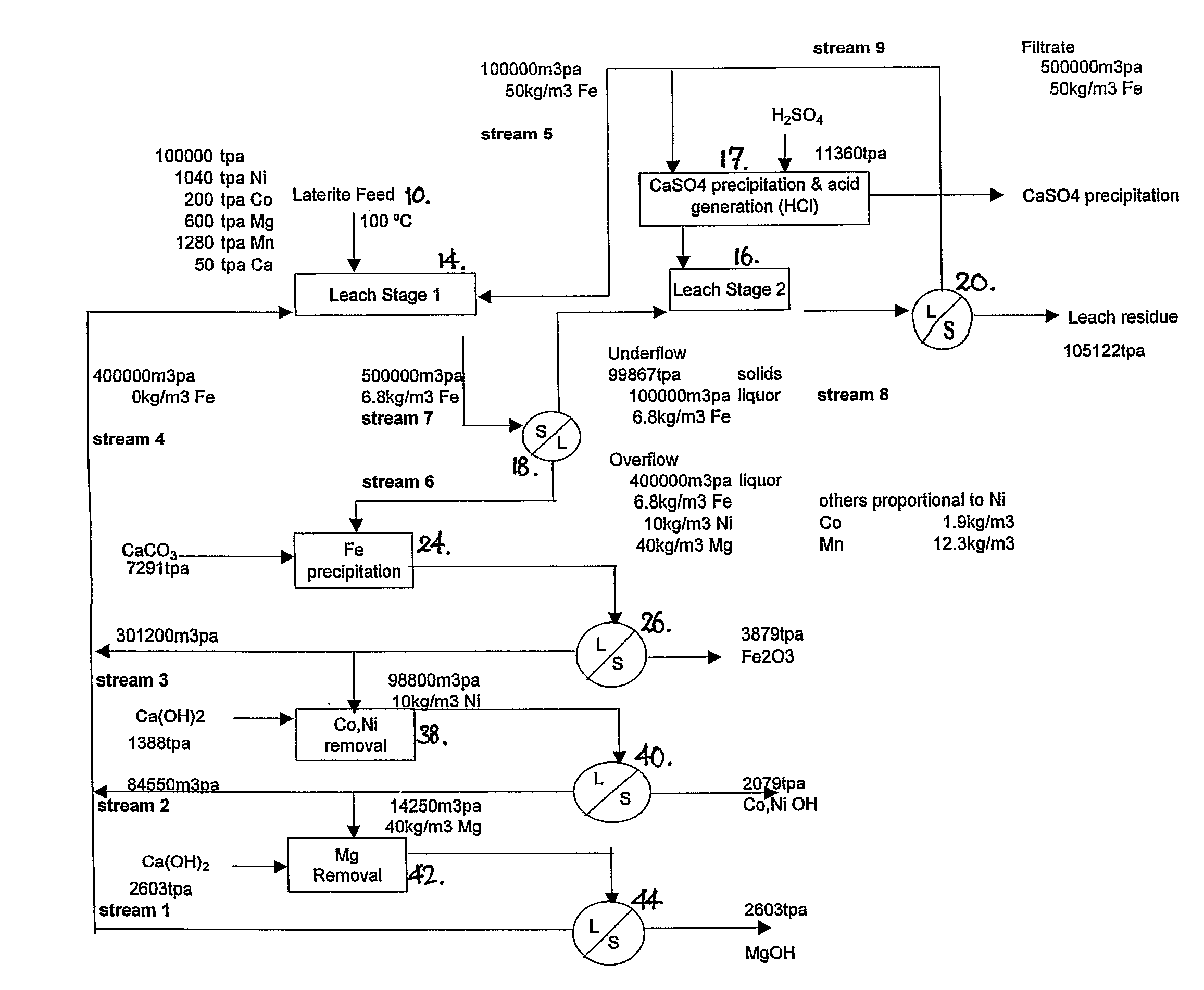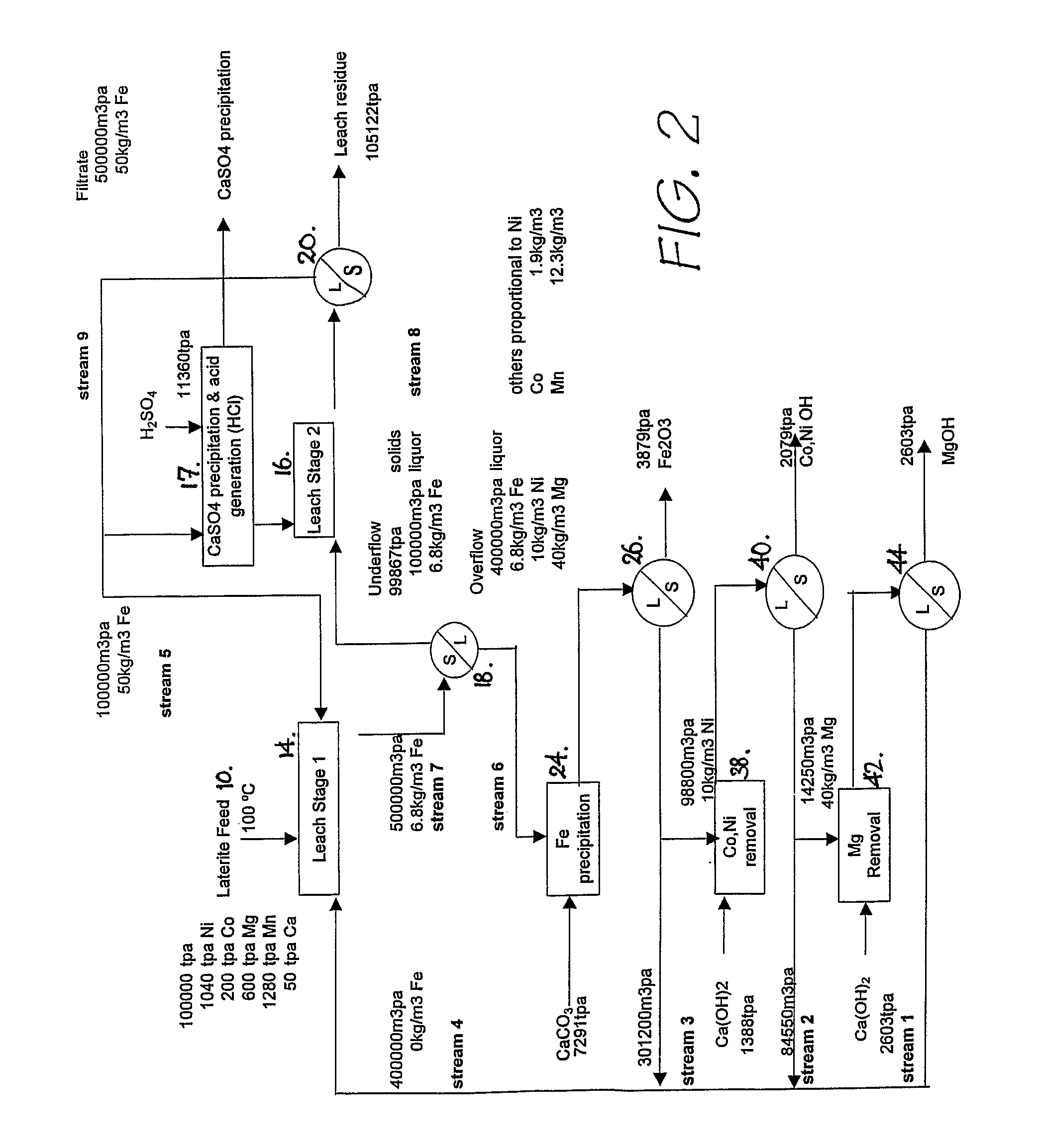Recovery Of Metals From Oxidised Metalliferous Materials
a metal and liferous material technology, applied in the direction of crystal growth process, alkali metal halide purification, dissolving, etc., can solve the problems of difficulty in controlling iron and magnesium leaching, corrosion and chloride resistance of the apparatus, and the hydrometallurgical recovery process to achieve the effect of maximising the target metal and stable and safe environmen
- Summary
- Abstract
- Description
- Claims
- Application Information
AI Technical Summary
Benefits of technology
Problems solved by technology
Method used
Image
Examples
example 1
[0084] A first process, hereafter referred to as the Intec Oxidised Metalliferous Materials Process (IOMMP) was developed as a halide-based alternative for the recovery of nickel and associated by-products from lateritic deposits. Previously the development of such deposits was generally by way of pressure acid leach (PAL) or high pressure acid leaching (HPAL).
[0085] The IOMMP employed a chloride medium, as opposed to the conventional sulphate medium in PAL and HPAL. The main advantage of the chloride medium is the ability to operate the leach at atmospheric pressure, without reliance on pyrohydrolysis to recover HCl for leaching and MgO for liquor purification.
[0086] The IOMMP was based on the input of H2SO4 for leaching and a calcium based alkali for purification, which eliminated the need for pyrohydrolysis. The IOMMP process was also not constrained by the types of halide salts employed. In this respect NaCl was a more cost effective source of chloride ion, whilst NaBr was abl...
example 2
Zinc Ferrite Leach Trial
[0111] A leach trial was carried out on a sample of zinc ferrite residue from an Electrolytic Zinc Plant to determine metal extraction efficiencies.
[0112] A 50 kg (wet) sample of the zinc ferrite was slurried at a density of 200 g / L in a brine formulated to match the process conditions for the first leach stage.
[0113] The brine had the following major components:
ConcentrationComponentg / LCaCl2280NaCl50FeCl350ZnCl275
[0114] The solution metal concentrations were monitored over time with the results shown in the table below.
DryTime[Fe][Cu][Pb][Zn][Ag]Weight(Hours)(g / L)(g / L)(g / L)(g / L)(ppm)TemppH(kg)020.51.06.236.4201050.0546.0121.0——40.4—1060.30—321.3——42.5—1060.55—522.5——43.7—1050.56—721.4——44.3—1060.48—923.4————1060.50—1124.61.67.645.4881060.4932.9
First Leach Stage
[0115] The leach residue from the first leach stage simulation was filtered and washed with water and analysed. The results are shown in the table below.
FirstFirstZnStageStageFerriteLeachLea...
example 3
EAF Dust Leach Trials
[0122] A series of leach trials were carried out on a sample of EAF dust. These types of materials were noted to be mainly composed of refractory zinc ferrites along with varying quantities of other more simple metal oxides formed at high temperatures in the electric arc furnace.
First Stage Leach
[0123] The effectiveness of the first stage leach was tested by preparing a slurry of 240 g of EAF dust in 4 litres of a bromide-based brine with the following composition.
ConcentrationComponent(g / L)CaCl285CuCl240FeCl3175PbCl210ZnCl2170NaBr100
[0124] The solution metal concentrations were monitored over time with the results shown in the table below.
TAgCuFePbZnDry wtMinutes(° C.)pH(ppm)(g / L)(g / L)(g / L)(g / L)(g)09020.356.77.079.72401091——————30942.120.250.37.097.6—60972.219.949.27.797.1—9097—19.949.17.697.4—120932.319.949.06.797.4—150942.419.949.16.095.1—180962.220.249.76.0—180
[0125] The leach residue from the first stage leach simulation was filtered and washed with...
PUM
| Property | Measurement | Unit |
|---|---|---|
| temperature | aaaaa | aaaaa |
| residence time | aaaaa | aaaaa |
| temperature | aaaaa | aaaaa |
Abstract
Description
Claims
Application Information
 Login to View More
Login to View More - R&D
- Intellectual Property
- Life Sciences
- Materials
- Tech Scout
- Unparalleled Data Quality
- Higher Quality Content
- 60% Fewer Hallucinations
Browse by: Latest US Patents, China's latest patents, Technical Efficacy Thesaurus, Application Domain, Technology Topic, Popular Technical Reports.
© 2025 PatSnap. All rights reserved.Legal|Privacy policy|Modern Slavery Act Transparency Statement|Sitemap|About US| Contact US: help@patsnap.com



